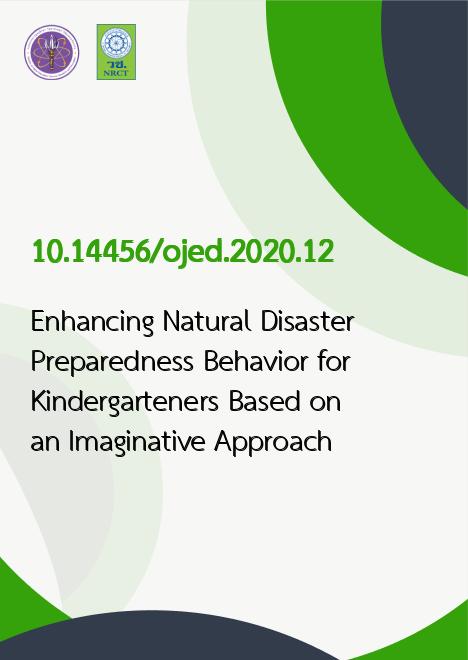
|
Enhancing Natural Disaster Preparedness Behavior for Kindergarteners Based on an Imaginative Approach |
|---|---|
| รหัสดีโอไอ | |
| Creator | Valaiporn Chandrasakha |
| Title | Enhancing Natural Disaster Preparedness Behavior for Kindergarteners Based on an Imaginative Approach |
| Contributor | Panutsorn Jaruchainiwat |
| Publisher | Centre for Education Innovation, Print and Online Media |
| Publication Year | 2563 |
| Journal Title | An Online Journal of Education, Chulalongkorn University |
| Journal Vol. | 15 |
| Journal No. | 2 |
| Page no. | OJED1502005 (13 pages) |
| Keyword | natural disaster preparedness, imaginative approach, kindergartener |
| URL Website | https://so01.tci-thaijo.org/index.php/OJED |
| Website title | An Online Journal of Education, Chulalongkorn University |
| ISSN | ISSN 1905-4491 (Online) |
| Abstract | The purposes of this research were 1) to develop a program of natural disaster preparedness for kindergarteners based on an imaginative approach; and 2) to study natural disaster preparedness behavior, which consists of identification of disasters and protection from or during disasters. This research was quasi-experimental in design, making use of a One-Group Pretest-Posttest Time-Series Design. The samples were eighteen Kindergarten-2 students in the 6th Cycle of Commemoration School. The method of study consisted of 3 phases, namely, construction, field test and revision of the program. The research duration was 10 weeks. The research instrument was a test of natural disaster preparedness behavior for kindergarteners. The data was statistically analyzed by using the arithmetic mean, standard deviation, repeated measures ANOVA and t-test.The research results were as follows: 1) After the experiment, the natural disaster preparedness behavior mean scores of the samples were higher than before the experiment at a .01 significance level. 2) After the experiment, the kindergarteners’ natural disaster preparedness behavior through participation in program had increased by 93.23 percent, which is higher than before the experiment at a .01 significance level. The program was made up of principles, objectives, features, content, implementation procedure and evaluation. Features of the program consisted of 3 content time frames for each disaster:1) Before disaster 2) During disaster 3) After disaster. There were 4 instructional processes: 1) Making wonder 2) Developing understanding 3) Learning discussion 4) Evaluation of knowledge and understanding. |